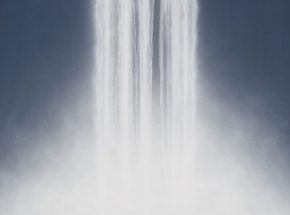

Hiroshi Sugito’s paintings convey dreamy scenes that resist easy reading. Several motifs recur in his images including drapes, curtains and stage-like sets. These elements suggest a world in ‘play’, perhaps visualizing narrative fictions that we can inhabit.
Sugito was born in 1970 in Nagoya. From the age of 3 until 14, he lived in New York. Sugito graduated from the Aichi Prefectural University of Arts in 1992. In 1996 he was the artist in residency at the Bemis Alternative Worksite Foundation in Nebraska. For a while, he split his time between the United States and Japan. Sugito currently lives and works in Nagoya.
Selected exhibitions include: in 2001, a group exhibition “Painting at the Edge of the World” at the Walker Art Center (Minneapolis); in 2004, a group exhibition “Real World – the Dissolving Space of Experience” at the Modern Art (Oxford,UK); in 2005, a solo exhibition “1996-2000” at the Marc Foxx Gallery (Los Angeles) and at the Nicole Klagsbrun Gallery (New York); in 2006, a solo exhibition “Focus: Hiroshi Sugito” at the Modern Art Museum of Fort Worth (Texas) and a solo exhibition “April Song” at The Sculpture Garden Museum, Vangi Museo (Shizuoka, Japan); in 2007, a solo exhibition “Under the Cloud” at the Nicole Klagsbrun Gallery (New York), a solo exhibition “Passage to the Sky” at the Tomio Koyama Gallery (Tokyo); and a group exhibition “The Door into Summer: The Age of Micropop” curated by Midori Matsui, at the Contemporary Art Center, Art Tower Mito (Ibaraki, Japan); in 2008, a solo exhibition “Triple Mountain” at the Galeria Fortes Vilaça (São Paulo, Brasil) and at the Kenji Taki Gallery (Nagoya, Japan and a group exhibition “The 7th Gwangju Biennale” Biennale Hall at the Gwangju Museum of Art (Korea); and in 2010, a group exhibition “Garden of Painting – Japanese Art of the 00s” at The National Museum of Art (Osaka, Japan).
Sugito received the Japan VOCA Encouragement Prize in 1997 and the Nagoya City Art Creation Award in 2000. His works are in the public collections of many institutions around the world including The Aichi Prefectural Museum of Art, The Museum of Contemporary Art in Tokyo and The San Francisco Museum of Modern Art.
Sugito has written about his work: “I guess invisible things should be kept invisible and unexplainable be kept unexplainable. When something appears or is put in, something disappears from the same moment. I am just chasing them like an endless game.”
www.japan.usembassy.gov/art/e/artres2010-sugito.html
